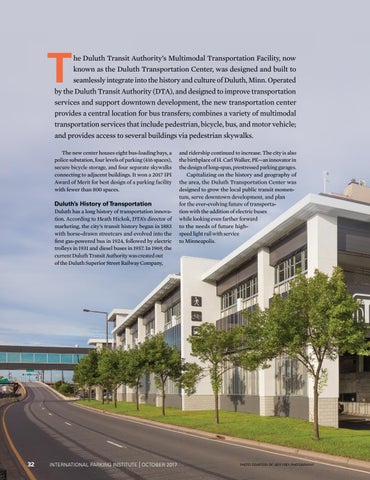T
he Duluth Transit Authority’s Multimodal Transportation Facility, now known as the Duluth Transportation Center, was designed and built to seamlessly integrate into the history and culture of Duluth, Minn. Operated by the Duluth Transit Authority (DTA), and designed to improve transportation services and support downtown development, the new transportation center provides a central location for bus transfers; combines a variety of multimodal transportation services that include pedestrian, bicycle, bus, and motor vehicle; and provides access to several buildings via pedestrian skywalks. The new center houses eight bus-loading bays, a police substation, four levels of parking (416 spaces), secure bicycle storage, and four separate skywalks connecting to adjacent buildings. It won a 2017 IPI Award of Merit for best design of a parking facility with fewer than 800 spaces.
Duluth’s History of Transportation Duluth has a long history of transportation innovation. According to Heath Hickok, DTA’s director of marketing, the city’s transit history began in 1883 with horse-drawn streetcars and evolved into the first gas-powered bus in 1924, followed by electric trolleys in 1931 and diesel buses in 1957. In 1969, the current Duluth Transit Authority was created out of the Duluth Superior Street Railway Company,
32
INTERNATIONAL PARKING INSTITUTE | OCTOBER 2017
and ridership continued to increase. The city is also the birthplace of H. Carl Walker, PE—an innovator in the design of long-span, prestressed parking garages. Capitalizing on the history and geography of the area, the Duluth Transportation Center was designed to grow the local public transit momentum, serve downtown development, and plan for the e ver-evolving future of transportation with the addition of electric buses while looking even farther forward to the needs of future highspeed light rail with service to Minneapolis.
PHOTO COURTESY OF JEFF FREY PHOTOGRAPHY
